by Scott Jackson | Nov 29, 2013
Check into the lodge at Wakulla Springs State park on a crisp cool evening and you are immediately greeted with the warmth of an open hearth fireplace and the security of stone walls radiating comfort and solace. These stately accommodations meet all your needs for refuge and rejuvenation with opportunities for an old fashion game of chess or checkers, great food, and time to reconnect with cherished friends and family.
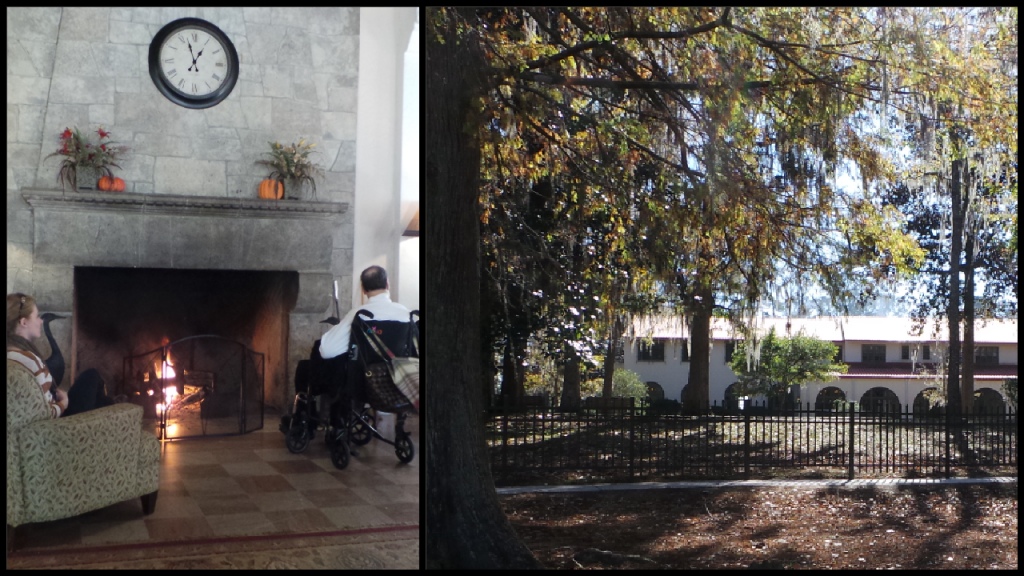
Wakulla Springs Lodge offers guests warmth and rest from the winter’s cooler weather just like the springs offers manatees refuge on winter’s coldest days. (Photos by L. Scott Jackson)
Wakulla Springs hosts about 200,000 visitors each year and is one of North Florida’s most popular swimming spots with peak attendance between April and August. It’s a great place to beat the heat on a hot summer’s day. The same cool 250 million gallons of 69F degree water that provides welcome relief to visitors on hot summer’s day also provides an inviting warm refuge on winter’s coldest days to another type of park guest, manatees.
Wakulla Springs is the Gulf of Mexico’s northernmost geographic location where manatees congregate and consistently overwinter in large numbers. Last week, park guides estimated 30 individuals in the springs and river run.
Florida Fish and Wildlife Conservation and Commission / Florida Wildlife Research Institute’s winter synoptic aerial survey of Florida’s manatees in 2011 totaled 4,834 individuals. Improved survey techniques have resulted in increased estimates for Florida manatees in recent years, however, they still remain listed as endangered.
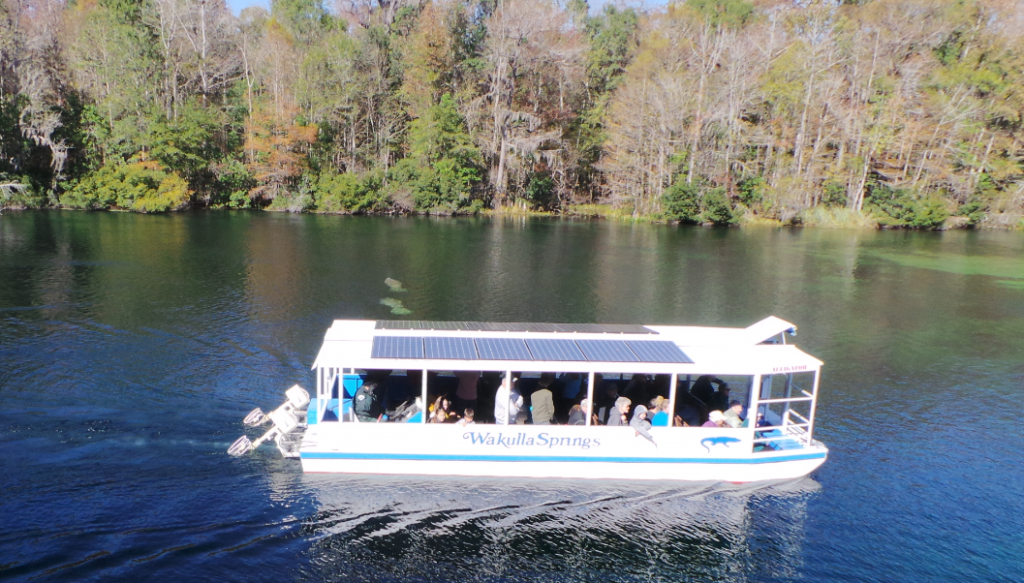
Daily river cruises on the Wakulla River are a great way to see manatees and other unique wildlife. (Photo by L. Scott Jackson)
Consistent water temperatures below 65F can result in stress, pneumonia, or colds in manatees. Other environmental conditions can also cause problems for manatees. This year, a large number of Florida manatee moralities have been reported as a result of a harmful algal bloom on the Atlantic Coast in the Indian River Lagoon. Florida manatees are also frequently struck by boat hulls and boat motor propellers; the signs of which are often seen in individuals with tell-tale propeller scars.
[youtube=http://www.youtube.com/watch?v=0D2tNXrQ5CI]
Education and stewardship are two of the best ways to help manatees. You can connect with these Florida ambassadors locally on a Wakulla Riverboat Tour at the State Park or through outfitters that provide kayaks and local guiding knowledge. Simple changes in home practices that protect water quality also protect the water resources used by manatees and other wildlife. Observing manatee protection zones and reducing boat speed also have been shown to reduce the impact of boating activities on manatees. To report sick or dead manatees, please call the FWC Wildlife Alert Hotline at 888-404-FWCC (3922).
Read more manatee facts in the following UF/IFAS publication: Life in the Sea.
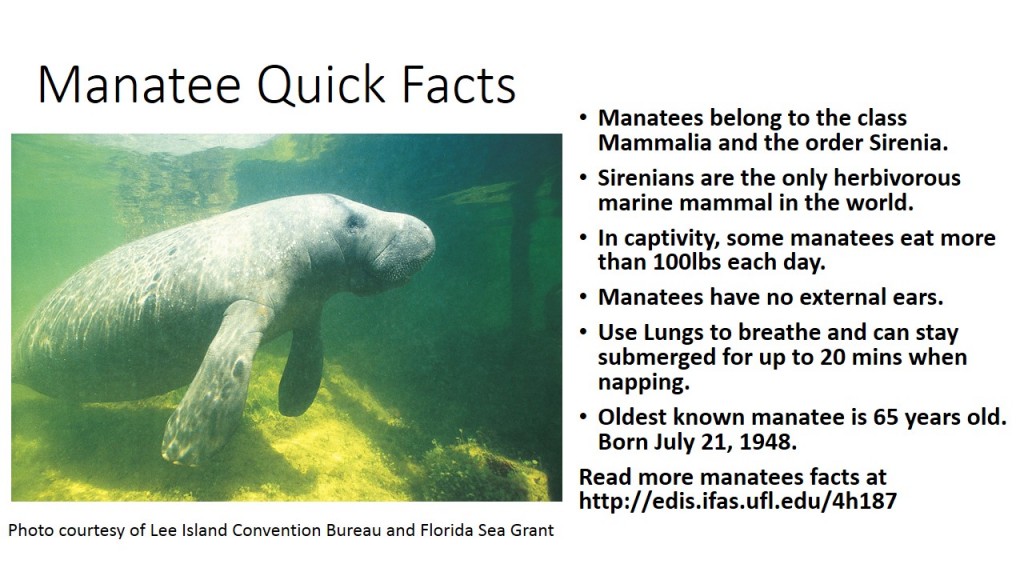
by Judy Biss | Jul 6, 2013
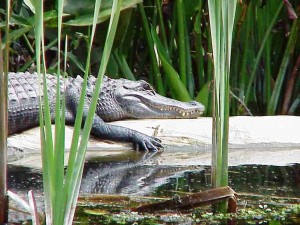
Summer is a time to bask in the sunshine for many of Florida’s wildlife species.
Each of Florida’s seasons are characterized by a variety of amazing and beautiful wildlife activities. Below is a list of some notable native wildlife behaviors occurring in July and August around the state.
July
Birds
- Shorebird migration starts in mid-July, peaking in August.
- Swallow-tailed kites begin gathering as do purple martins and tree swallows in preparation for migrating south for the winter.
- Look out for nesting shorebirds, and keep your vehicles and dogs from disturbing them.
Reptiles
- Later this month, young alligators and crocodiles will begin to hatch.
Mammals
- Baby raccoons, foxes, armadillos, possums, and bobcats leave dens and begin following parents.
Plants
- Sea oats flower along the Atlantic and Gulf.
- Scrub morning glory and butterfly weed begin to bloom.
Of Special Historical Note:
August
Birds
- First flocks of blue-winged and green-winged teal arrive to winter on Florida lakes and wetlands.
- Yellow warbler migration begins.
Mammals
- Two-year old black bear cubs will wean from their mothers.
- Short-tailed shrews will begin a second round of breeding for the year.
Reptiles
- Young sea turtles are hatching so avoid marked sea turtle nests and turn off lights to reduce light pollution.
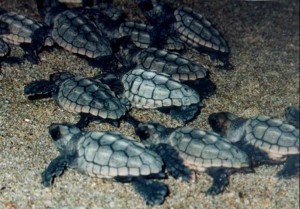
Sea turtle hatchlings are attracted to light sources on their dash to the ocean. Summer hatching means lights out for sea turtles! photo by L Avens 2003
Insects
- Thousands of great southern white butterflies can be seen migrating through coastal areas.
Invertebrates
- Corals along the Keys spawn at the full moon
More of these “happenings” for the calendar year can be found at the University of Florida’s Wildlife Extension Website: Wildlife Happenings.
Also at the Wildlife Extension website are a number of interesting resources to learn not only about our native wildlife, but our non-native/invasive wildlife as well. For example: can you distinguish between the invasive Cuban treefrog and our native species? The Cuban treefrog is well established in central and south Florida and has been documented in Bay and Leon Counties in north Florida. Be on the lookout for this alien treefrog!
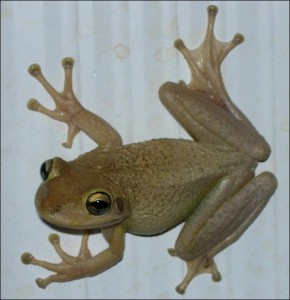
Natural habitats invaded by Cuban Treefrogs include pine forests, hardwood hammocks, and swamps. In urban and suburban settings they are most commonly found on and around homes and buildings, and in gardens and landscape plants – Image by Dr. Steve A Johnson 2005.
On the flip side, did you know that our “own” American Bullfrog is invasive in other countries throughout the world? Also, current research is investigating the observations that mating calls of some non-native frogs may interfere with the dynamics of native frogs’ calling behavior. These and other up-to-date facts can be found in the UF/IFAS Invader Updater newsletter. The current issue has articles on the suckermouth catfish, Cuban treefrog, lampreys, and the recent record-sized python caught in south Florida.
Focusing back to our own unique native wildlife, you may find, as I did, this UF website of Frogs & Toads of Florida of interest to you. It has beautiful pictures of each species as well as an audio recording of its distinctive call. So, turn up the volume on your speakers and listen to a sampling of the chorus that serenades Floridians each night. Click Here to listen to the call of the Squirrel Treefrog.
by Bill Mahan | Apr 19, 2013

Horseshoe crabs spawning.
Credit: Bill Hall, Univ. Delaware Sea Grant

Horseshoe crabs spawning on a beach.
Credit: FL Fish & Wildlife Commission

The female is the larger of the two horseshoe crabs.
Credit: Fotosearch -Stock Photo
Spring is here and that can only mean one thing, horseshoe crabs! That’s right it’s horseshoe crab survey time!
Each spring the scientists with the Florida Fish & Wildlife Conservation Commission (FWC) look for volunteers to report horseshoe crab sightings around the state as part of their annual horseshoe crab survey.
So, if you would like to be part of the research team, all you need to do is get out and walk along the beach and let FWC researchers know when you see horseshoe crabs. Please see the information at the end of this article for submission information. The following is some background information on horseshoe crabs.
About Horseshoe Crabs
- The horseshoe crab is found on shores of the western Atlantic Ocean ranging from Maine to Mexico. Fossils of horseshoe crab ancestors show that these animals have been around for over 350 million years – before the age of dinosaurs. Therefore, it is no surprise that scientists typically refer to horseshoe crabs as “living fossils.”
- Interestingly, horseshoe crabs are not really crabs at all! As it turns out, they are more closely related to spiders and scorpions than they are to true crabs. This is because unlike true crabs, horseshoe crabs do not have antennae or jaws, and their legs are similar to those found on spiders.
- Currently, horseshoe crabs are being harvested commercially for three purposes in the United States: bait (conch & eel fisheries); marine life (aquarium trade, research, etc.); and biomedical (for blood).
- Compared to other states, especially along the Atlantic coast, Florida does not have a large horseshoe crab fishery. The primary harvest in Florida is for marine life.
- Horseshoe crabs are ecologically important. During certain times of the year, horseshoe crabs lay billions of eggs on beaches. These eggs are an important food source for migrating birds and the marine wildlife.
- Horseshoe crabs are also directly important to humans because research on their compound eyes has lead to a better understanding of the human visual system.
- In addition, horseshoe crab blood is widely used by the biomedical industry. Special cells in their blood (which by the way is blue) are used to test for bacterial contamination in our blood supplies and in the production of many commercial drugs. A horseshoe crab’s blood contains hemocyanin, a copper – based molecule that gives it a blue color.
- Finally, the material that makes up their exoskeleton (chiton) is used to make contact lenses, skin creams, and hair sprays.

The blood of the horseshoe crab is blue because it is copper-based.
Credit: FL Fish & Wildlife Commission
Horseshoe Crab Anatomy
- The tail of the horseshoe crab is often thought to be a weapon by many people. However, the horseshoe crab is actually harmless and the tail is used to dig through sand and to turn the crab upright if it is accidentally turned over.
- The first pair of legs can be used to distinguish between males and females. Males use their specialized front legs, called claspers, to hold on to the female during spawning.
Project Objectives and Goals
Currently, horseshoe crabs are being over-harvested in some states. The management plan issued by the Atlantic States Marine Fisheries Commission requires that all Atlantic coastal states must identify horseshoe crab spawning beaches.
With your help! – FWC’s goal is to identify horseshoe crab spawning beaches around Florida.
How can you help?
FWC is asking the public to report sightings of horseshoe crab activities. The information that the researchers would like to collect from you is the following:
- Date and time of your sighting.
- Location of your sighting.
- Whether or not horseshoe crabs were spawning.
- A rough estimate of the number of horseshoe crabs seen.
Spawning behavior of horseshoe crabs is best observed within three-days before and after a full or new moon on sandy beaches with low wave action.
If you want to be more involved, you can contact the FWC researchers about collecting data on abundance of male and female horseshoe crabs, and on sizes of individuals. You can contact FWC using any of the following methods:
Go to MyFWC.com/Contact and click on the “Submit a Horseshoe Crab Survey” link, then “Florida Horseshoe Crab Spawning Beach Survey,” or go directly to http://www.surveymonkey.com/s/horseshoe_crab
- You can also report findings via email at horseshoe@MyFWC.com
- Or call toll-free at 1-866-252-9326

If you have any questions please let me know. Enjoy your beach walks and “crab” watching.
(Bill Mahan is a FL Sea Grant Agent and Director of the Franklin UF-IFAS Extension Program. Contact him at (850) 653-9337 , 697-2112 x 360; via e-mail at bmahan@ufl.edu; or Facebook http://www.facebook.com/UFIFASFranklinExtension
, 697-2112 x 360; via e-mail at bmahan@ufl.edu; or Facebook http://www.facebook.com/UFIFASFranklinExtension
by Brooke Saari | Mar 3, 2013
National Invasive Species Awareness Week: March 3rd – March 8th
March 3rd: Tropical Soda Apple (Solanum viarum) & Lionfish (Pterois volitans):
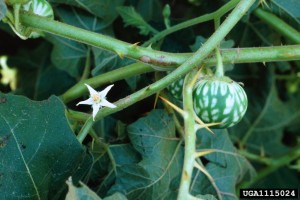
Tropical Soda Apple Photo Credit: Jeffrey Mullahey, UF, Bugwood.org
Tropical Soda Apple: Florida ranchers know Tropical Soda Apple (TSA) as the “Plant from Hell.” It was first noticed in south Florida, but its seeds survive in the digestive tracts of animals and it spread north through the movement of hay and cattle. TSA plants are covered with thorns and can make large sections of pasture nearly useless for livestock. Concerted efforts to lessen the population of TSA since its arrival have reduced the populations in pastures but it persists in sheltered or waste locations. Cattle, birds, deer and feral hogs ingest the mature fruits and spread the plants to loafing and browsing areas that may be inaccessible to mechanical treatment with anything larger than a hoe. According to Dr. Jeff Mullahey, who has been working on TSA since its appearance in south Florida, one plant can produce 40,000-50,000 seeds with seed germination ranging from 75%-100%. The seeds remain viable for at least three years. Be on the lookout for these while engaged in outdoor activities.
Isolated plants can be controlled by mechanical means. You won’t want to pull them up barehanded, though. Additional information and control methods are available at http://edis.ifas.ufl.edu/uw097, or contact your local Extension agent.
For more information contact the author Jed Dillard, Livestock & Forages Extension Agent by phone at 850-342-0187 .
.
Lionfish: The Red Lionfish is a non-native invasive predatory reef fish that has spread throughout Florida waters. Lionfish are members of the family Scorpaenidae; all members are venomous and the lionfish is no exception. This fish is relatively small, typically ranging from 12-15 inches in length with a zebra-like appearance and long, showy pectoral fins. They have a row of long, dorsal spines that contain venom glands. Their native range is the South Pacific and Indian Oceans and preferred habitat is on offshore reef structures. These fish are considered to be voracious eaters feeding on native fish, reducing vital native populations, and competing for food with native fish such as grouper and snapper.
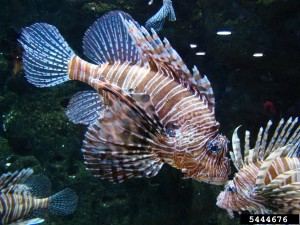
Lionfish, Photo Credit: Rebekah D. Wallace, UGA, Bugwood.org
With few predators, these fish are thriving in Florida waters, even in the northern Gulf of Mexico. They reproduce often, sometimes all year, with their eggs hatching after about two days. They also consume a variety of local species, causing 80% decline in reef fish recruitment and loss of some economically important species. These fish are able to expand their stomachs for large meals and can survive starvation for over 12 weeks. These fish are an invasive species in our local waters and removal is encouraged. The most effective control of this species is removal by human. These fish are cryptic and nocturnal so locating them can be tricky. Spearfishing is the method of choice, since lionfish rarely bite a hook and line. Florida Fish and Wildlife Commission (FWC) changed regulations to increase harvesting opportunities. Such changes include no requirement for a recreational fishing license when using spearing devices (pole spear, a Hawaiian Sling, handheld net, or spearing devices marked for use on lionfish), and no recreational or commercial bag limit, though recreational fishing license is required for other fishing methods. Check the FWC regulations before fishing or diving for these species.
Lionfish are venomous and must be handled carefully. Venom glands occur on the dorsal, pelvic and anal spines. Lionfish sightings should be reported at 877.786.7267 . If stung seek medical attention as soon as possible. Rarely are stings fatal unless the person has an allergy to the venom. The Poison Help Hotline can be reached at 800.222.1222
. If stung seek medical attention as soon as possible. Rarely are stings fatal unless the person has an allergy to the venom. The Poison Help Hotline can be reached at 800.222.1222 . Sighting information is being collected to track the movement of these species. Fill out the online report on the USGS website or the REEF website. Stay up to date on research as it pertains to this species at www.flseagrant.org.
. Sighting information is being collected to track the movement of these species. Fill out the online report on the USGS website or the REEF website. Stay up to date on research as it pertains to this species at www.flseagrant.org.
For more information contact the author Brooke Saari, Sea Grant Marine Science Extension Agent, 850-689-5850
by Scott Jackson | Feb 28, 2013
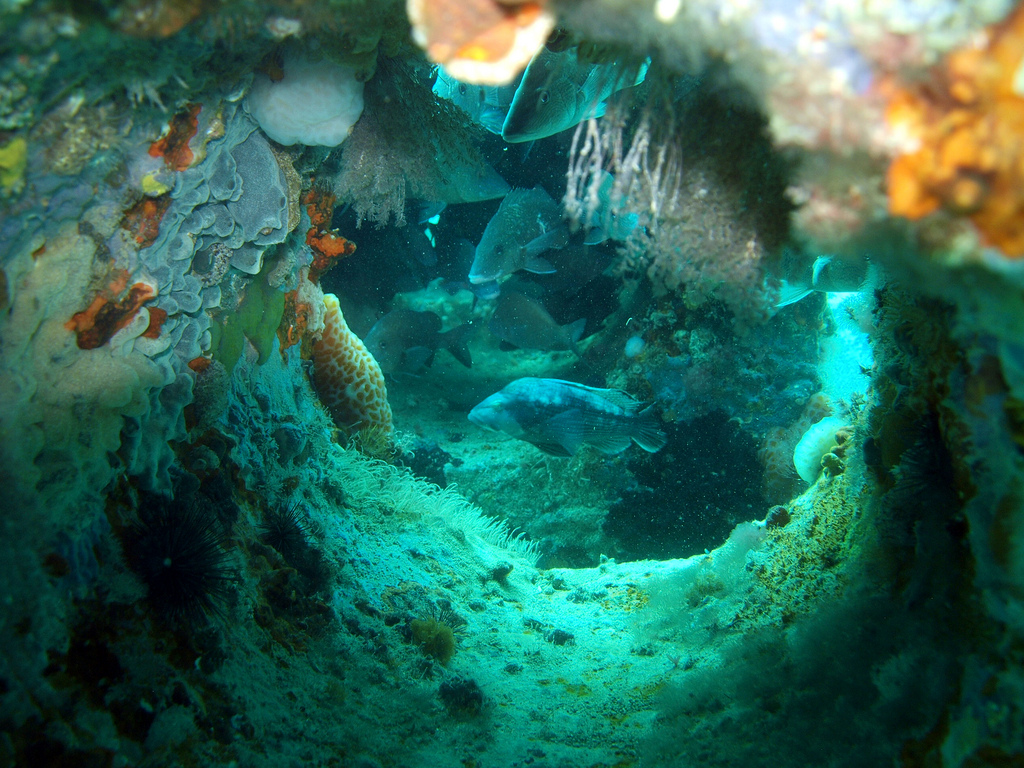
Fish swimming in cube reef located near Taylor County, Florida.

One of the highlights from last week’s Northwest Florida Artificial Reef Workshop was the panel discussion which included Bill Lindberg, Bob Shipp, Will Patterson, and Luiz Barbieri. These researchers provided information regarding the current state of reef fisheries in the Gulf. Additionally, they suggested strategies for use of artificial reefs. Please view the session recording by clicking here.
by Carrie Stevenson | Jan 3, 2013
It is human nature to explore. We are a curious species, yearning from birth to stimulate our senses of sight, smell, touch…from an infant’s grab at a colorful toy to an astronaut setting foot on the moon, we thrive on new adventures and understanding. A legend of the Age of Exploration, Spanish explorer Ponce de Leon set foot on Florida’s coast in 1513, and 500 years later, another water-based expedition is taking place. This time, the explorer sets out not to conquer, but to celebrate the unique ecology and history of Florida. On January 1, University of Florida graduate Justin Riney, founder of a nonprofit advocacy group called Mother Ocean, launched a 365 day standup paddleboard journey around the state. Several standup paddleboarding enthusiasts (myself included) joined him at Big Lagoon State Park in Pensacola to begin the 1,515 mile Florida Circumnavigational Saltwater Paddling Trail, which hugs the coastline south through the Keys and back north to Jacksonville.
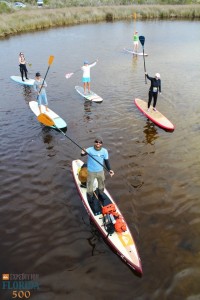
The author (top right) participates in the launch of Expedition Florida 500 at Big Lagoon State Park on January 1. Photo Credit: Jackson Berger
Justin plans to paddle for at least 10 miles a day, carrying all of his gear on his board and camping at beaches in each community. The goal of the trip is not only to help celebrate the 500th anniversary, but he’s partnered with the Florida Department of Environmental Protection, the University of Florida, and several watersports companies to promote the expedition and highlight conservation of the springs, rivers, estuaries and beaches around our state. He hopes the journey will inspire people to explore and protect our invaluable water resources, and encourages locals to join him at each location to paddle and share knowledge about their waterways. Along the route, he has scheduled almost three weeks to take daylong tours in areas of particular ecological and historical significance. Today several of us joined him on a trip through Pensacola Bay, where we discussed everything from the history of Fort Pickens, to the improvement of water quality in Bayou Chico, to the Appalachian origins of our sugar-white sands.
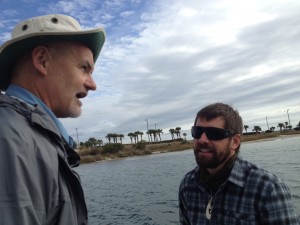
Captain Robert Turpin, Escambia County Marine Resources (left), discusses seagrass preservation in Little Sabine Bay with Justin Riney.
In several communities, he plans to lead coastal cleanups. Justin will be paddling from Pensacola through Gulf Breeze tomorrow and to south Okaloosa and Walton counties through January 11. From there, he will continue along the coast, and on to Bay and Franklin counties between the 15-26 of this month. The detailed schedule below outlines his route from the Panhandle and beyond.
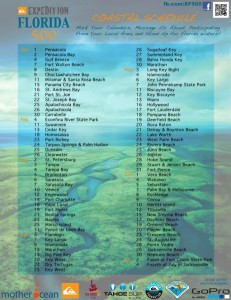
Coastal Schedule for Expedition Florida 500
You can follow Justin’s experiences at Expedition Florida 500 on Facebook to see updates, photos, and information about where he will be next. If you’re a standup paddleboarder, kayaker, or just interested in the project, contact him through the page and take the time to be part of this historic journey. And for those of you who live further inland, after reaching Jacksonville on July 4, he plans to paddle back through the state exploring inland waterways–rivers, springs, and lakes–so there’s a good chance Expedition Florida will come to your community this year as well!

















